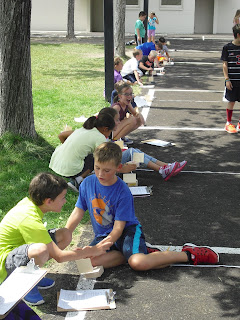Welcome!
Some people learn about the world from the Discovery Channel. Others explore it. Be an explorer!
Friday, August 28, 2015
Enjoying the School Garden
Today we had the opportunity to go harvest lettuce and cucumbers from the school garden. After harvesting it, students got to enjoy great salads. In fact, they wanted seconds! You would have thought they were bowls of gummy worms or Starbursts. It is fun to see where your food comes from and eat it within minutes of harvesting it.
Creative Juices are a Flowing
On Thursday, Mrs. Osgard led a short science lesson focusing on kinetic and potential energy of catapults. Small groups had 30 minutes to gather various supplies off a table and make a catapult. Many different varieties existed, and based on the time constraint, the groups did great. Having to quickly figure out a basic design, work together to build it, and having specific supplies, it is amazing what was built!
Wednesday, August 26, 2015
Ice Age Carvings
Students are putting themselves back in time as they become a person who lived toward the end of the last Ice Age. Using soap to mimic stone, students thought up some figurine that might be carved by an early inhabitant to the Americas. Today their story will be recorded to go along with their carving.
Catapults
We began our unit on catapults last week. Students made individual catapults that shot marshmallows. Observations took place on the effects of gravity (in several different aspects). Math was involved as students computed mean (average) to determine the release angle of the arm that shot the marshmallow the furthest.
Monday, August 17, 2015
Archaeology
Today was our archaeology dig. Each team had a quadrant to dig in, and many young archaeologists brought in tools and gloves to do so. The goal was to allow the fifth graders to understand that much of our history is based on what is discovered from ancient civilizations and we don't always have a complete picture. Each team, upon discovering and artifact had to record where it was found in the quadrant and then photograph the artifact. Once returning to the classroom students worked as a team to complete an archaeology dig report, where they analyzed the artifacts and the civilization(s) they came from. Groups who found limited artifacts had less "clues" in understanding their civilization(s).
Building Teamwork
This year, teamwork will be an essential asset to possess in our class. Journeys Outdoor School, our overnight trip, will have one day focused to building teamwork. In class the first week we began the foundation for working together this year. Having 6 cups, teams had to use a string and rubber band to manipulate the cups into different positions. Looking easy at first, the entire team had to work together in order to be successful.
Tuesday, August 11, 2015
Importance of Observations
We had our first science lab, which stressed the importance of detailed observations. Each student received a stick, which looked similar in all ways to the other 27 sticks in class. As students wrote down observations, mini lessons occurred that reminded them of key concepts while writing observations (scaled drawings, labels, measure accurately in the metric system, detailed shading or coloring, weighing, having multiple drawings of different angles, etc.). All sticks were collected and the following morning students reviewed their lab book notes. All sticks were spread out and students, had to find their own stick and PROVE it was theirs using their notes. This was very successful and done within 8 minutes.
Next, we discussed how often times other people utilize notes that scientists write. These need to be detailed enough and legible so others know what the scientist is talking about. Students clarified their notes and then had a challenge. They had to switch notebooks and only rely on the notebook to help them find a peer's stick. Much more difficult, yet it set a stage for the importance of putting down all information in a detailed way so others (mainly me while I am grading their labs this year) know ALL of the information that is inside each of their heads. A very successful lab to start with.
Subscribe to:
Comments (Atom)






























